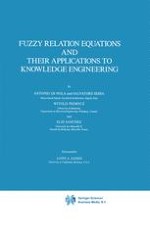It took many decades for Peirce's coneept of a relation to find its way into the microelectronic innards of control systems of eement kilns, subway trains, and tunnel-digging machinery. But what is amazing is that the more we leam about the basically simple coneept of a relation, the more aware we become of its fundamental importanee and wide ranging ramifications. The work by Di Nola, Pedrycz, Sanchez, and Sessa takes us a long distanee in this direction by opening new vistas on both the theory and applications of fuzzy relations - relations which serve to model the imprecise coneepts which pervade the real world. Di Nola, Pedrycz, Sanchez, and Sessa focus their attention on a eentral problem in the theory of fuzzy relations, namely the solution of fuzzy relational equations. The theory of such equations was initiated by Sanchez in 1976, ina seminal paper dealing with the resolution of composite fuzzy relational equations. Sinee then, hundreds of papers have been written on this and related topics, with major contributions originating in France, Italy, Spain, Germany, Poland, Japan, China, the Soviet Union, India, and other countries. The bibliography included in this volume highlights the widespread interest in the theory of fuzzy relational equations and the broad spectrum of its applications.
